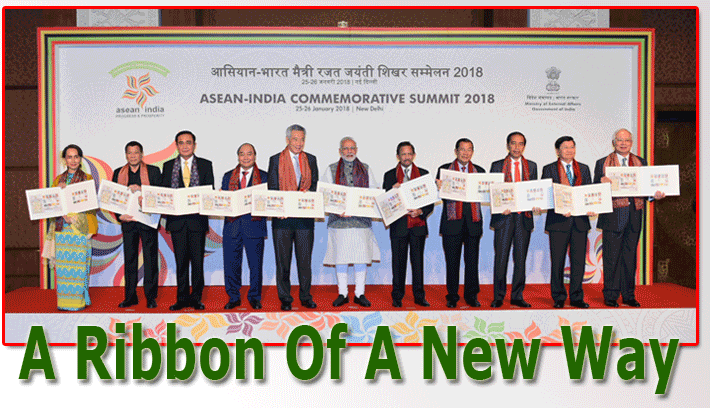
Prime Minister Narendra Modi with the ASEAN
Heads of State and Governments and the ASEAN Secretary General on
the occasion of the release of postal stamps to commemorate the
silver jubilee of the India and ASEAN partnership at the ASEAN India
Commemorative Summit in New Delhi. |
Better late than never . . . In what can best be described as a move that should
have come a few years ago, India has reached out to the Association of
Southeast Asian Nations (ASEAN).
(Political commentators, however, point
out that India’s overtures to the ASEAN was more due to the Chinese
presence in the region or, as one commentator mentioned, “An anesthetic
solution to China’s growing assertiveness in the region.”)
Whatever the reason, Prime Minister Narendra
Modi’s invitation to ten leaders from the ASEAN for India’s
Republic Day to commemorate 25 years of dialogue partnership has kick-started
the relationship. As the Indian Prime Minister pointed out in a signed
editorial, which appeared in 27 newspapers and in 10 languages, the relationship
had moved from dialogue partnership to strategic partnership.
Business
Needs Connectivity
Indian overtures aside, what emerged at
the end of the ASEAN-India Commemorative Summit was a firm push towards
bringing more connectivity between India and the ASEAN. A move, indeed,
in the right direction since quite a few of these nations’ capitals
do not have direct commercial flights connecting Delhi (Philippines, Vietnam,
and Indonesia, for example).
It may be mentioned that Narendra Modi also
invited Singapore Airlines to expand its operation in India and start
flight services to cities like Guwahati in Assam, according to secretary,
East, in the external affairs ministry.
The official also said that Vietnam would
soon start direct flight services to India.
In fact, full service airline Vistara—a
joint venture between Tata Sons and Singapore Airlines—will start
its international operations by the second half of the calendar year 2018,
Chief Executive Leslie Thng announced recently. Vistara will initially
start its short-haul international operations connecting South Asian destinations
and other Asian destinations that are 2-4 hours away, followed by destinations
3-5 hours away, Thng said.
The Delhi Declaration of the ASEAN-India
Commemorative Summit highlights the connectivity issue. The Heads of State
reaffirmed a commitment to “deepen cooperation in the area of aviation
under the ASEAN-India Aviation Cooperation Framework adopted at the 14th
ASEAN Transport Ministers’ Meeting in Manila, on November 6, 2008
[and] establish closer ASEAN-India air links to promote tourism, trade,
and enhance greater connectivity between ASEAN and India.”
The leaders also agreed to “strengthen
cooperation in the area of aviation and maritime transport and look forward
to the expeditious conclusion of the ASEAN-India Air Transport Agreement
(AI-ATA) and the ASEAN-India Maritime Transport Agreement (AI-MTA).”
Long Standing Issues
The air connectivity issue has been raised
time and again, but there has been little action on the ground.
Way back in 2003, then-Prime Minister Atal
Bihari Vajpayee had advocated an Open Skies arrangement between the ASEAN
and India.
Five years later, in 2008, the ASEAN-India
Aviation Cooperation Framework was adopted—and that was it. The
result: Not only has tourism between the ASEAN and India not gone up,
neither has trade.
India has been recording the highest number
of air travellers but Indians accounted for only 3 percent of all tourist
arrivals in ASEAN. As for trade between ASEAN and India, it was at a low
2.6 percent.
Connectivity—otherwise described as
the “new Great Game” by India’s former Foreign Secretary
Subrahmanyam Jaishankar—could indeed be the game changer.
Study Cited
In a study done some time ago by the Associated
Chambers of Commerce and Industry of India (ASSOCHAM), it was mentioned
that, “though ASEAN-India economic engagements are moving forward
in the desired direction, yet there are certain challenges that call for
policy interventions. With the signing of the ASEAN India Agreement in
Services and Investments, ASEAN and India are likely to benefit from an
extended market, where the air connectivity aims to play a pivotal role.
The issue of enhancing air connectivity is one of them. The major issues
and challenges related to promoting air connectivity between ASEAN countries
and India pertain to growing demand for air cargo services; facilitating
business and leisure tourists by having more direct flights connecting
Tier II and Tier III cities of India…”
Tirthankar Ghosh
|




 Vol.
17 No. 19
Vol.
17 No. 19